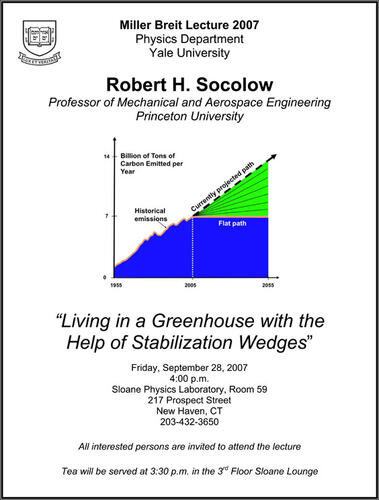
The Yale Physics Miller-Breit Lecture was given on September 28, 2007 by Robert Socolow, Professor of Mechanical and Aerospace Engineering, Princeton University.
Friday, September 28, 2007 - Living in a Greenhouse with the Help of Stabilization Wedges
In 2004 Steve Pacala and I introduced the “stabilization wedge” as a useful unit for discussing climate stabilization. A wedge is the reduction of global CO2 emissions by one billion tons of carbon per year in 2057. Any campaign or strategy designed to mitigate carbon emissions can be measured in wedges. Implementing eight wedges should enable the world to achieve the interim goal of emitting no more CO2 globally in 2057 than today, and in the following 50 years driving CO2 emissions to net zero emissions would place humanity, approximately, on a path to stabilizing the climate at a concentration less than double the pre-industrial concentration. Eight wedges may be available from an aggressive, globally coordinated scale-up of a mix of already commercialized or nearly commercialized technologies.
Carbon numeracy needs to become part of general education. Increasing the competitiveness of carbon mitigation technology and accelerating its delivery worldwide are challenges that need the attention of the most talented researchers.